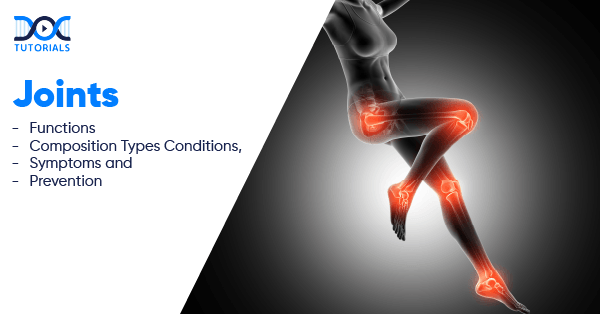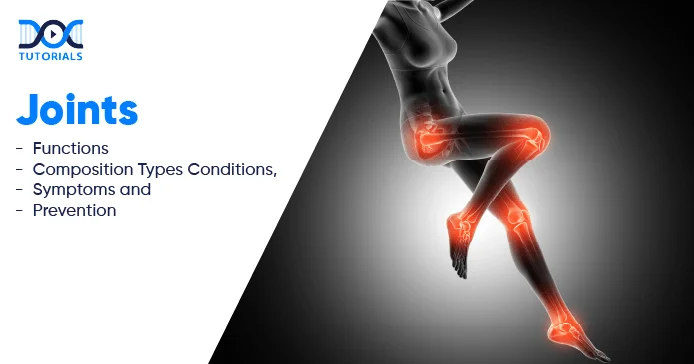Joints: Functions, Composition, Types, Conditions, Symptoms, and Prevention

Joints are essential components of the human body that connect bones, allowing us to perform everyday activities. Joints aid mobility and offer support to the body. Without joints, even simple movements, such as running and walking, would be impossible.
Understanding joints, their structure, functions, types, and associated conditions is essential for medical students, particularly those preparing for NEET PG. In this article, we will explore everything about joints in detail.
What are Joints?
A joint is formed when two or more bones meet at a point. This enables movement and provides stabilization to the body. Joints are often referred to as articulations.
The human body has several types of joints, and they can be classified in multiple ways based on:
- Function: How they allow movement.
- Composition: What they’re made of.
Functions of Joints
Joints serve some of the most important roles, such as:
- Movement: Joints allow a wide range of motion, from simple bending to complex rotations. For example, the shoulder’s ball-and-socket joint allows versatile arm movements, while the knee’s hinge joint supports bending and straightening.
- Support: Additionally, joints help support body posture, like the spine, which lets us stand straight and keep our balance.
Composition of Joints
Joints are composed of various tissues and structures, each playing a critical role:
- Bones: The bones form the basic foundation of a joint. The type of joint determines the particular movement.
- Cartilage: The cartilage is a flexible covering at the ends of the bones that is smooth and rubbery. It protects joints from wear and tear that comes from repetitive movements.
- Synovial Fluid: This is a lubricating fluid found in synovial joints. It reduces friction and can absorb tremendous amounts of impact.
- Ligaments: Ligaments are strong, fibrous bands connecting bones to stabilize joints and prevent excessive movement.
- Tendons: Tendons are like ligaments, with the difference that they attach muscles to bones, making movement at joints possible. They allow muscles to contract and expand while transferring the tension from muscle contraction.
- Bursae: Bursae are small, fluid-filled sacs that cushion joints and reduce friction between bones, muscles, and tendons. They are commonly found around knees, elbows, and shoulders.
- Meniscus: A meniscus is a crescent-shaped cartilage found in certain joints, such as the knee, providing additional cushioning and stability.
Types of Joints
Joints are classified into 3 types based on their structure and function:
1. Fibrous Joints
Fibrous joints have limited flexibility, and some don’t move at all. They are composed of tough connective tissue, primarily collagen.
- Sutures: Hold the bony plates together. They are found in the skull.
- Gomphoses: Joints that anchor teeth into the jawbone.
- Syndesmosis: Connect two adjacent bones, like the tibia and fibula in the lower leg.
2. Cartilaginous Joints
These joints are cushioned by cartilage and offer limited movement. Examples include the joints where ribs meet the sternum and the pubic symphysis joint connecting the left and right pelvic bones.
3. Synovial Joints
These are the most mobile joints. Synovial joints are defined as a cavity filled with fluid, which is surrounded by a synovial membrane. This facilitates smooth motion and minimal friction.
- Hinge Joints: Permit motion in a singular direction, much like a door (elbows and knees).
- Ball-and-socket Joints: Allow multi-directional movement (hips and shoulders).
- Condyloid Joints: Restrict full rotation and allow movement between two oval-shaped bones (wrists, fingers, and toes).
- Pivot Joints: These joints permit whirling motions (the neck joint that permits the head to be rotated).
- Planar Joints: Enable shifting actions between two flat bones (wrist joints and vertebrae of the spine).
- Saddle Joints: Allow movement in multiple directions between two U-shaped bones (thumb joint).
Common Joint Conditions
Joints can suffer from various medical conditions, causing pain, swelling, or restricted movement. Common joint-related issues include:
- Arthritis
- Osteoarthritis
- Bursitis
- Tendinitis
- Osteoporosis
- Rheumatoid arthritis
- Psoriatic arthritis
- Lupus
- Sports injuries
- Bone fractures
- Dislocations
- Sprains
Symptoms of Joint Disorders
Early recognition of joint issues is vital. Common symptoms include:
- Pain
- Swelling
- Redness or discolouration around the joint
- A sensation of warmth or heat
- Grinding or popping sounds
Prevention of Joint Disorders
Although some joint conditions stem from genetics or ageing, many are preventable with healthy habits, such as:
- Balanced Diet: Focus on nutrients that support bone and joint health.
- Regular Exercise: Low-impact activities like swimming, cycling, strength training, and water aerobics help maintain joint function.
- Protective Gear: Wear suitable protective equipment during sports, physical work, or risky activities.
- Routine Checkups: Visit healthcare providers regularly and address any joint discomfort.
- Seatbelt Use: Always use a seatbelt to prevent joint trauma during accidents.
FAQs about Joints
1. How many bones does the human body have?
Adults typically have about 350 joints. However, experts often disagree on the exact number of joints in the human body. Most agree that a joint is where two bones meet, but some argue that only movable connections should be counted as joints.
2. What is a hinge joint?
A hinge joint moves in one direction, like a door hinge, allowing bending and straightening. Examples include the knee and the elbow.
3. What is a ball and socket joint?
A ball-and-socket joint consists of a rounded bone end fitting into a cup-like socket. It allows a wide range of motion. The shoulders and hips are examples of ball-and-socket joints.
4. Who is at risk of developing osteoporosis?
Women are most at risk due to lower estrogen levels, especially after menopause. Age, family history, and lifestyle also play a significant role.
5. Which joint connects the thumb to the hand?
The saddle joint connects the thumb to the hand, allowing it to move in different directions for better grip and flexibility.
Conclusion
Understanding the structure, types, functions, and potential conditions affecting joints is essential for NEET PG aspirants. Recognizing early symptoms and embracing preventive measures, maintaining healthy joints, and an active lifestyle becomes achievable, contributing to a better quality of life overall. DocTutorials offers NEET PG courses, question banks, high-quality video lectures, mock tests, mentorship, and more. Enroll to boost your medical journey today!
Latest Blogs
-

NEET PG Exam 2025- Date, Pattern, Marking Scheme, Subject Wise Weightage, and Exam Mode
NEET PG Exam 2025 is the ultimate gateway for medical graduates aspiring to pursue postgraduate courses in medicine, including MD,…
-

INI CET Exam 2025: Your Roadmap to Success – Key Topics, Strategies, and Lessons from Last Year’s Papers
The INI CET exam is more than just a test; it’s a significant milestone for many medical students aiming to…
-

INI CET Exam Success: Previous Year Question Papers & Ultimate Guide – INI CET PYQ
One can feel overwhelmed while preparing for the INI CET (Institute of National Importance Combined Entrance Test). A vast syllabus,…





